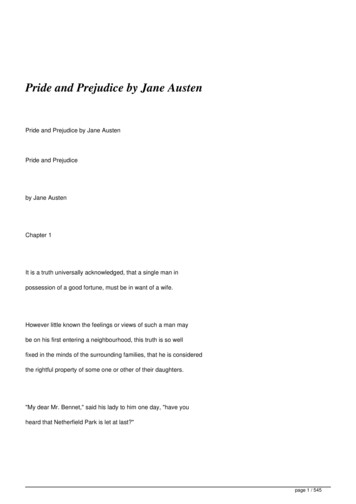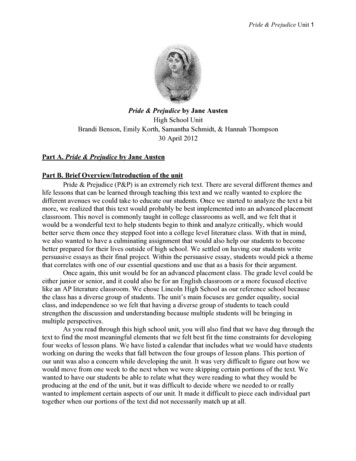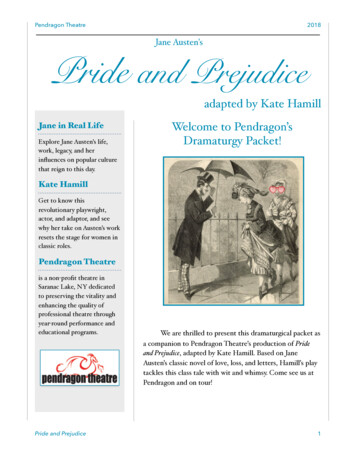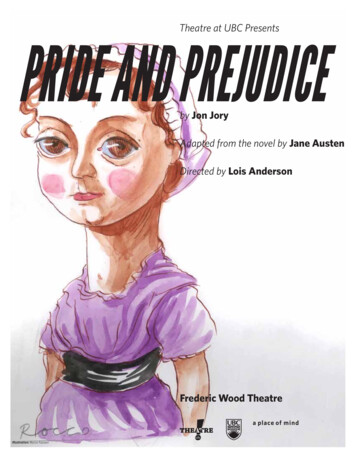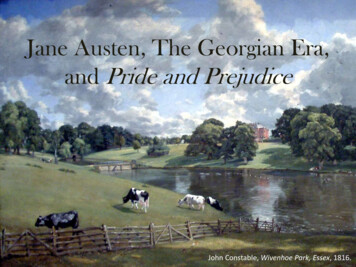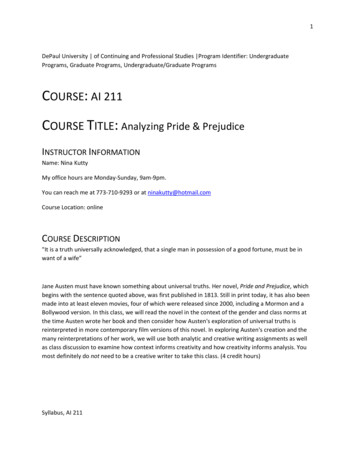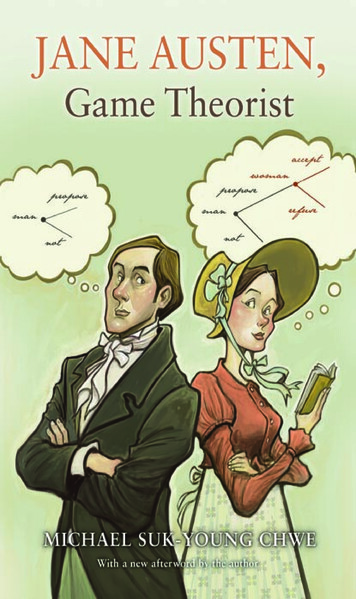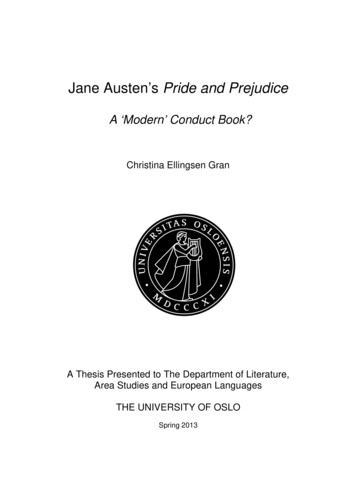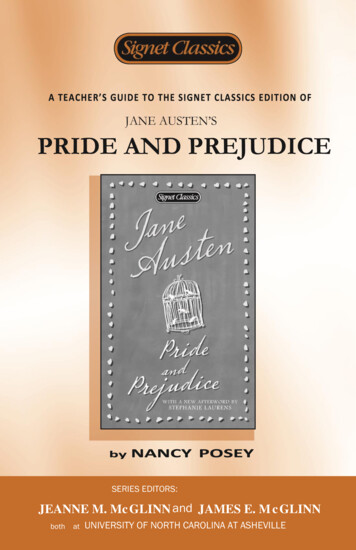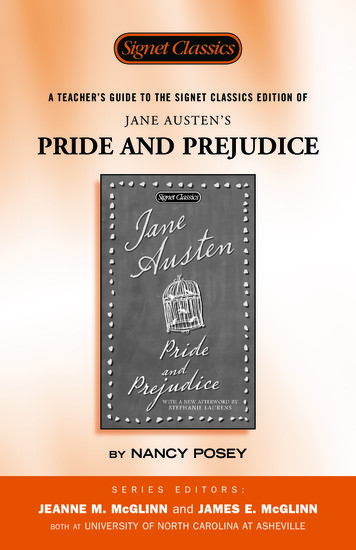
Transcription
A TEACHER’S GUIDE TO THE SIGNET CLASSICS EDITION OFJ A N E AU S T E N ’ SPRIDE AND PREJUDICEbyNANCY POSEYS E R I E SE D I T O R S :JEANNE M. McGLINN and JAMES E. McGLINNboth atUNIVERSITY OF NORTH CAROLINA AT ASHEVILLE
2A Teacher’s Guide to the Signet Classics Edition of Jane Austen’s Pride and PrejudiceTABLE OF CONTENTSIntroduction.3List of Characters.3Synopsis of the Novel.4Pre-Reading Activities.6I. Building Background Knowledge .6II. Genre Study . .10III. Initial Exploration of Themes.11During Reading Activities.13I. Noting Initial Reactions .13II. Reader Response.14III. Focusing on the Literary Elements .15IV. Discussion Questions.18V. Vocabulary Development.21After Reading Activities.22I. Analysis of Initial Reactions.22II. Deepening Understanding.23III. Individual and Group Projects.24More Resources for Teachers .30About the Author of This Guide.30About the Editors of This Guide.30Free Teacher’s Guides.31Copyright 2009 by Penguin Group (USA)For additional teacher’s manuals, catalogs, or descriptive brochures,please email academic@penguin.com or write to:PENGUIN GROUP (USA) INC.Academic Marketing Department375 Hudson StreetNew York, NY 10014-3657http://www.penguin.com/academicIn Canada, write to:PENGUIN BOOKS CANADA LTD.Academic Sales90 Eglinton Ave. East, Ste. 700Toronto, OntarioCanada M4P 2Y3Printed in the United States of America
A Teacher’s Guide to the Signet Classics Edition of Jane Austen’s Pride and Prejudice3INTRODUCTIONFor a young woman living a presumably insular life in Regency England, Jane Austenproduced an impressive body of works that has continued to grow in popularity. She wasborn in 1775 in Hampshire, England to a parson’s family, and she left home only for fiveyears to attend boarding school and for occasional visits to siblings. Surrounded by booksall of her life, she found an eager audience for her writing among her close-knit family.Although she never married and had only one serious romance, her novels of courtshipand marriage have remained favorites.Austen completed the first draft of Pride and Prejudice, which she titled First Impressions,in 1797, but it was not published until after she had rewritten it nearly sixteen years later.Of her six complete novels, Pride and Prejudice seems to have been her favorite. In a letterto her sister Cassandra she referred to the book as her “darling child” and called herprotagonist Elizabeth Bennet “as delightful a character as ever appeared in print.”Jane Austen’s work seems little touched by political events in her world or by major literarytrends of her day. She focuses instead on themes of social class, middle class manners,gender issues, courtship and marriage, all of which come together in Pride and Prejudice.Perhaps it is these timeless themes that draw readers back again and again to this novel.This guide aims to assist teachers in planning to teach the novel in ways that will make itaccessible to the range of readers in contemporary classrooms. To this end there aresuggestions for preparing students to read the novel with sensitivity to Austen’s setting andthemes. During-reading activities are included that will facilitate students’ reading thenovel actively with comprehension. The post-reading activities are aimed at encouraging adeeper exploration of the content of the novel and making connections with other literaryworks. The variety of activities presented here can be used selectively by teachers inaddressing their goals for teaching the novel and responding to the needs of their students.LIST OF CHARACTERSTHE BENNET FAMILY AND FRIENDSElizabeth Bennet—protagonist, the second of five daughters; pragmatic and independent;her father’s favoriteMiss Jane Bennet—Elizabeth’s older sister; wants to see the best in everyone;Mary Bennett—the plain, bookish middle sisterMiss Catherine (Kitty) Bennett—easily led and shallow fourth daughterLydia Bennet—the youngest sister, flirty and undisciplinedMr. Bennet—their father, cynical and permissiveMrs. Bennet—their mother, whose main goal is to find husbands for her daughtersCharlotte Lucas—Elizabeth’s best friendSir William and Mrs. Lucas—The Bennets’ neighbors
4A Teacher’s Guide to the Signet Classics Edition of Jane Austen’s Pride and PrejudiceMr. Collins—the Bennet girls’ overbearing cousin, a priggish clergyman who stands toinherit Longbourn, the Bennets’ entailed estateThe Gardiners—Mrs. Bennet’s brother and sister-in-law who live in LondonGeorge Wickham—an attractive militia officer stationed near the BennetsTHE BINGLEY FAMILY AND FRIENDSMr. Charles Bingley—unmarried, wealthy young man who has leased nearbyNetherfieldMiss Caroline Bingley—Mr. Bingley’s sisterMrs. Hurst—Bingley’s married sisterMr. Hurst—Bingley’s brother-in-lawMr. Fitzwilliam Darcy—Bingley’s prideful, wealthy friendMiss Darcy—Darcy’s sisterCol. Fitzwilliam—a relation of Darcy whose status as second son leaves him with little wealthLady Catherine de Bourgh—a condescending wealthy snob; patron of Collins; aunt of DarcySYNOPSIS OF THE NOVELVOLUME ICHAPTER 1-6 MEETING THE BENNETS AND THEIR NEIGHBORSThe narrator introduces the Bennet family and Mrs. Bennet’s interest in their newneighbor, Mr. Bingley, “a single man of large fortune,” who has just rented NetherfieldPark. After several dinners and visits, it is obvious that Bingley is attentive to Jane.However, his friend Darcy snubs the group, particularly Elizabeth, and is judged criticallyby the locals. The two men are contrasted—their personalities as well as theircircumstances—as are Jane and Elizabeth and their judgments. Visiting their neighborsthe Lucas’s, Mrs. Bennet and the girls have a chance to discuss Bingley and Darcy atlength. Jane withholds her feelings, while Charlotte Lucas has a more pragmatic view ofmarriage. Readers learn that Darcy has taken an interest, against his will, in Elizabeth.CHAPTER 7-12 VISIT TO NETHERFIELDJane is invited to Netherfield by Bingley’s sisters, and, caught in the rain on her way,comes down with a bad cold. Elizabeth goes to check on her and is invited to stay as well.She is able to observe the others’ true colors without Jane’s presence. Mrs. Bennet andLydia come to Netherfield to check on Jane, and Elizabeth is caught betweenembarrassment for her mother and family loyalty. Elizabeth and Darcy engage in a battleof wits. When Jane’s health improves, the girls return home.
A Teacher’s Guide to the Signet Classics Edition of Jane Austen’s Pride and Prejudice5CHAPTER 13-22 MR. COLLINS VISITS LONGBOURNMr. Bennet receives a letter from Mr. Collins, the male heir in line to inherit the family’sentailed estate (since there are no sons). He proves to be a silly man, easily impressed bywealth and status. During his visit, the group encounters Wickham, a member of the militiastationed at Meryton for the winter. It is clear that he and Darcy are not on friendly terms.All the neighborhood eagerly anticipates a ball at Netherfield, hosted by Bingley. Elizabethis dismayed by Collins’ interest in her, Wickham’s absence, and the behavior of her family.She and Darcy dance and verbally spar. The next day, Collins proposes marriage toElizabeth and is surprised by her refusal. Mrs. Bennet presses for the match, though herhusband does not. Spurned by Elizabeth, Collins instead proposes to Charlotte Lucas, whoaccepts but not out of love. Jane learns that the Netherfield party has returned to Londonwith no plans to return. Bingley’s departure and the prospect of Charlotte as mistress ofLongbourn displease Mrs. Bennet.VOLUME IICHAPTER 1-3 CHANGING IMPRESSIONSA letter from Miss Bingley to Jane, which suggests that Charles Bingley is courting Miss Darcy,ends her hopes that he will return. Meanwhile Collins makes preparations for his marriage,and the Gardiners, Mrs. Bennet’s brother and his wife, invite Jane for a visit to London.She accepts with some hope perhaps of seeing Bingley. Jane’s letters to Elizabeth indicateshe now sees Miss Bingley for what she is. Elizabeth is no longer involved with Wickham.CHAPTER 4-14 ELIZABETH AND THE GARDINERS VISIT THE COLLINSElizabeth visits her aunt and uncle, traveling with them to visit Charlotte and Mr. Collinsat their home in Hansford. They find Collins little changed, but Charlotte quite content.They are invited to Rosings, where they get a clear view of the imperial Lady Catherineand her mousy daughter. During their stay, Darcy arrives with his cousin Col. Fitzwilliam.Elizabeth and Darcy continue their verbal jousting.Elizabeth encounters Darcy often—at Rosings and on her walks. She learns fromFitzwilliams Darcy’s role in separating Bingley and Jane. Darcy catches Elizabeth offguard with his proposal of marriage, an offer she turns down cold. Darcy later approachesher and gives her a letter explaining his behavior toward Wickham, Jane, and Bingley. Shere-reads the letter until she finally sees the truth and her feelings begin to waver.CHAPTER 15-19 JANE AND ELIZABETH RETURN HOMEJane and Elizabeth return home where they find Lydia and Kitty still infatuated by thesoldiers who will soon be leaving for Brighton. Elizabeth reveals to Jane secrets of Darcy’sproposal and Wickham’s true character but withholds the truth about Bingley’s feelings.Lydia receives an invitation to visit Brighton with the Forsters, leaving Kitty dejected,Elizabeth worried, and Mrs. Bennet ecstatic. Elizabeth learns that a proposed trip to theLake Country is cancelled, but instead she and her aunt and uncle will visit Derbyshire—and particularly Lambton, Mrs. Gardiner’s girlhood home.
6A Teacher’s Guide to the Signet Classics Edition of Jane Austen’s Pride and PrejudiceVOLUME IIICHAPTER 1-3 VISIT TO PEMBERLEYWhen the Gardiners wish to view Pemberley House, Elizabeth goes along reluctantlyafter reassurances that Darcy is away from home. However, he surprises them by an earlyreturn. She is embarrassed but surprised by his civility and his wish that she meet hissister. He calls on Elizabeth and the Gardiners with his sister and Bingley, inviting themto dinner. The Gardiners take note of Darcy’s behavior toward Elizabeth.CHAPTER 4-11 LYDIA’S ELOPEMENTElizabeth receives letters revealing Lydia’s elopement with Wickham and the party immediatelyreturns to Longbourn. Here they learn that the two have not married. Mrs. Bennet takesto her bed, and their father joins Gardiner to search for the couple. Meanwhile, the restof the family waits for mail. Mr. Bennet returns, unsuccessful and full of self-reproach.Gardiner notifies the family that the couple has been found. Upon receiving a modestmonetary settlement, Wickham agrees to marry Lydia. Bennet suspects he is indebted tohis brother-in-law for the settlement and for arranging Wickham’s transfer to the North.After the ceremony, the new couple is allowed to visit Longbourn, where Lydia andWickham are completely shameless. Mrs. Bennet is thrilled to have a married daughter.CHAPTER 12-19 MARRIAGE PROPOSALSBingley and Darcy return to Netherfield and call on the Bennets. Bingley displaysgenuine affection to Jane and asks for her hand. Darcy remains distant until his aunt,Lady Catherine, visits the Bennets and demands that Elizabeth disavow any connectionbetween her and Darcy. Elizabeth’s refusal gives Darcy hope and he soon proposes. Hisproposal surprises her family, but the marriage takes place with the family’s blessings.PRE-READING ACTIVITIESThese activities are designed to build students’ background knowledge about the plot,characters, and themes. Choose the activities that best fit the themes you plan to teachor your goals for students’ learning.I. BUILDING BACKGROUND KNOWLEDGEPROBLEM SITUATIONSFollowing are three brief situations to help students think about conflicts based on class,family, and character. Choose one or more for students to read and respond to. Thestudents can share their answers with a partner and discuss them with the class. While attending a school dance, you hear one of the more popular students mockingyou and your group of friends. How do you act when you are placed on a schoolcommittee with him or her?
A Teacher’s Guide to the Signet Classics Edition of Jane Austen’s Pride and Prejudice7 Every time you are with your friends and their families, your mother says and doesthings that embarrass you in front of others. She doesn’t seem aware that she ishumiliating you or that others are laughing at her behavior (and perhaps at youbecause of her). What do you do at the time? What, if anything, do you say to herabout her actions afterwards? You are given information that one of the new students who is well-liked by otherstudents and well-respected by your teachers is actually dishonest, deliberatelymisleading others. Should you reveal the truth or just wait for others to discoverwhat you know already?ANTICIPATION GUIDEStudents should first respond to the following statements under the Pre heading (for prereading). Then conduct a class survey to see how students responded and ask why. Or youcan ask students to identify the statement that elicited the most response in them, eitherpositive or negative, and free write about their reactions. This will lead to an interestingclass discussion in which students share their beliefs and expectations. After reading thenovel, have students indicate how the author would have answered the questions. Alsohave them mark their own post-reading responses. Follow up with a class discussion tosee if students changed their answers to any of the questions and why. (You may alsoencourage students to share how they think the different characters would respond.)Pre Author Postnnn1. First impressions are often wrong.nnn2. Children are rarely justified in being embarrassed by their parents.nnn3. Parents should have some say about whom their children marry.nnn4. Families should be concerned with what others think.nnn5. Love at first sight is a common occurrence.nnn6. People communicate more effectively in the twenty-firstcentury than they did during the nineteenth century.nnn7. “Happiness in marriage is entirely a matter of chance”(Charlotte, 21).nnn8. Playing “hard to get” is useful in attracting members of theopposite sex.nnn9. People are happiest when they marry within their own social class.EXPECTATIONS AND PREDICTIONS1.Before beginning to read the novel, ask students: Who has read the novel? Who hasseen the movie? What expectations—if any—do they have about the novel? List theideas that are generated in this discussion on a class chart and post. During reading,go back to this chart from time to time to see if students wish to revise and/or addto the ideas.
8A Teacher’s Guide to the Signet Classics Edition of Jane Austen’s Pride and Prejudice2.To anticipate some of the plot and themes of the novel, begin by showing a film clipof the ball scene in which Darcy insults Elizabeth—the “first impression.” You mayalso choose to read the parallel passage from page 9 (“An invitation to dinner wassoon.”) to the last full paragraph on page 11 (which begins “Mr. Bingley followed hisadvice”). Then ask students to record their predictions: What romances will develop?What clues help you to predict a happy ending? What conflicts seem obvious?3.Read the first chapter (pages 3-5) aloud to students or have them read it themselves.Ask the students to record their answers to the following questions: What are yourfirst impressions of Mr. Bennet and Mrs. Bennet? On what do you base thoseimpressions? Whose viewpoint does the opening sentence seem to reflect?JANE AUSTEN’S WORLD1.Have students conduct a preliminary investigation of Jane Austen’s world,particularly around the time in which the novel is written and is set. You may havethem work in groups to research the following topics in order to create drawings,models, or other visual presentations of their findings to share with the class. As anoption, you can have the students post their findings to a class website, wiki, orGoogle document to use as a reference throughout the reading. What is the Regency Period? Who is in power in England? (Regent, George III) How is Austen’s world affected by such international developments as theNapoleonic War, the American Revolution, and the French Revolution? What elements of popular culture mark this period? Research styles of dress,art, music, dance, and games.Suggested tp://www.pemberley.comAs students share their findings, have them:2. Predict the influence these historical events and cultural elements will have onthe novel. Use their research to compare the activities of young people in the late 18thcentury to the lives of teens today. These comparisons may be a starting pointfor a discussion of the lasting popularity of Pride and Prejudice (and other Austennovels). In a whole class discussion, chart the similarities and the differencesbetween 18th century and 21st century lives. Culminate with a journal-writingactivity, asking students to use the findings to discuss which differences arepositive and which are negative. For example, parlor games of Austen’s day mayhave afforded more opportunities for socializing and communicating withothers, while video games today may encourage quick thinking and motor skills.Compare the culture of the Bennets (and Jane Austen) to culture today. Ask studentsin small groups to list in order of priority the forms of communication they usetoday. Which of these communication methods were available to Austen and to her
A Teacher’s Guide to the Signet Classics Edition of Jane Austen’s Pride and Prejudice9characters? What is the students’ primary means of communication? What do theygain or lose by using this method? In what way was the communication of Austen’sday richer? How might the people of the day have been affected by the lapse of timebetween writing and reading letters?3.On a map of England, have students locate the sites mentioned in the novel, as wellas those important to Austen’s life (Bath, Winchester, Brighton, London,Herefordshire, Derbyshire, the Lake District, Kent, Lambton, Steventon). Thefollowing links provide detailed maps of real and fictional places related to /maps.htmlDisplay the maps in the classroom for reference while reading the novel. You mayask students to mark actual locations with one color and fictional locations withanother. Discuss the effectiveness of Austen’s using real locations as well as fictionalplaces in order to bring her setting to life for readers.PROPERTY AND STATUS IN 18TH-CENTURY ENGLANDAn introduction to some concepts of British society will help readers recognize thelimitations imposed on many of the characters. Direct the students to conduct aninternet research to learn about the following: primogeniture, entailment, preferment.Useful resources are the following:http://www.huffenglish.com/?p #collinsbennetDuring reading, assign small groups of students one of the families in the novel so theycan use this research to determine life options for the children in each family: GeorgianaDarcy, Miss Bingley, Col. Fitzwilliam, Maria Lucas (Charlotte’s sister), Anne de Bourgh(Lady Catherine’s daughter), and the Gardiners’ four children.Discuss with the students the options available to an unmarried woman or a second (orsubsequent) son. Students may remember the concept of entailment from reading To Killa Mockingbird. Ask students if they recall Scout’s classmate Walter Cunningham and thediscussion about how Atticus was helping his father deal with an entailment. What wouldhappen to members of a family as a result of an entailment? How would they be limited?What is the purpose of entailments? How do they protect the wealth of a family,especially if the main source of wealth is the land? For more information, see thefollowing lesson plan site for an activity on social class in the early nineteenth centuryand detailed student assignments:http://edsitement.neh.gov/view lesson plan.asp?id 776#01JANE AUSTEN’S BIOGRAPHYThere is no shortage of information on Jane Austen and her works that will provideadditional insights to students as they read the novel. Assign students to read several onlinebiographies of Austen’s life, focusing on the following questions: What is known about thelife of Jane Austen—her family’s status, siblings, personal experiences? Why did shebecome a writer? How was she supported in her writing? How popular were her novels?
10A Teacher’s Guide to the Signet Classics Edition of Jane Austen’s Pride and PrejudiceFollowing are some useful web sites:Jane Austen’s WorldThe Republic of PemberleyJane Austen Society of North During reading ask students to compare and contrast what they have learned aboutAusten’s life and characteristics to those of her protagonist Elizabeth Bennet. Studentscould note these comparisons in a reading journal, paying attention to the followingtopics: family members, social status, courtship and marriage, education, and travels.Encourage students to note details about Austen’s life that are not a part of thecharacterization of Elizabeth. For example, Austen is the daughter of a minister, but thenovel has no mention of religion or Elizabeth’s father’s work.CROSS-CURRICULAR CONNECTIONSAs students begin the novel, explore the culture of the period. In preparation for followup research, you may assign students to explore areas of particular interest. They can lookat the topics broadly at first and then narrow to a more specific focus as they prepare afollow-up essay or presentation of information. Classical Music—for example, Beethoven, Rossini, Schubert, Liszt and Mendelssohn Dance—Shift in popularity from country dances to the waltz which was consideredcontroversial during Austen’s day Art—David, Turner, Constable History—Napoleonic Wars, French Revolution, American Revolution (Note thatAusten makes no reference to military actions in this novel, although this was aperiod of great change through war.) Science—Industrial Revolution, steam locomotion Religion—the Evangelical movement, mysticism and other trends in religionduring the late 18th and early 19th century Other areas—architecture, fashion, food, ory/regencyarts.htmlThis site covers dance, art, music, religion, literature, science and technology of the html#famportThis site provides several excellent examples of art/ illustrations of life in the period.II. GENRE STUDYTHE NOVEL IN 18TH-CENTURY ENGLANDJane Austen follows in the footsteps of earlier writers of the novel, a genre which came intopopularity in the late 17th and early 18th centuries. Review with students the names ofearlier novelists. What do they recall about their novels? Use the following sites to create
A Teacher’s Guide to the Signet Classics Edition of Jane Austen’s Pride and Prejudice11a timeline of the history of the novel, placing Austen and Pride and Prejudice in history/default.htmThe power point found at this online location provides a broad history of the 2012/NovelOL.pptDiscuss with students: Shifting popularity of poetry and fiction. Why is one considered more respectablethan the other at different points in time? Rising acceptability of female writers. Why, according to family reports, did Austenhide her writing when outsiders entered the room? Why did many female writers,such as the Bronte sisters, use masculine pseudonyms?THE ROMANCEAssign students to read pages 372-374 of the “Afterword” by Eloisa James. Note how themeaning of the term “romance” when applied to literature has changed over time. Havestudents research the definition of romance, historical romance, and romantic comedy intheir literature textbook or a handbook of literary terms. Discuss with students: How doliterary definitions of the romance vary from general associations? Why would EloisaJames’ family have “banned” romance in their home?SATIREAusten’s novels are often identified as “novels of manners” because she critiques socialcustoms, conventions, and behaviors of a particular social class at a specific time andplace. Introduce the concept of satire by making connections to satirical books andcultural forms with which the students are familiar—from Huck Finn to Saturday NightLive. Ask students to name examples of satire in their own culture. You may bring inexamples from political cartoons, clips from The Simpsons or SNL before asking studentsto collect and share their own examples. Resource: http://politicalhumor.about.comAsk students to brainstorm elements of their own society and culture that could becriticized. Discuss how these elements of society might be satirized in fiction. Then havestudents freewrite, satirizing an aspect of contemporary society. Share in pairs and thenwith the whole class.III. INITIAL EXPLORATION OF THEMESPrepare the students to read the novel at a deeper level by exploring several key themesbefore they read the novel. These explorations create an atmosphere of inquiry, encouragingstudents to discuss openly their responses and attempts to develop understanding.PRIDE, PREJUDICE, AND FIRST IMPRESSIONS1.Have students work with a partner to create a list of qualities on which people judgeothers. Ask them to go through their lists and determine whether the judgment basedon each quality is justified or not. As the pairs share, compile the list of qualities onthe board. Ask students to share their opinions concerning the justification of
12A Teacher’s Guide to the Signet Classics Edition of Jane Austen’s Pride and Prejudicejudging persons based on each quality. What can one know for certain about a personbased on first impressions? What factors lead to wrong conclusions? You mightprovide students with an example by discussing how we often judge persons by theirappearance. What can we truly tell about a person by their dress (perhaps age, gender,neatness)? Can you tell for certain if someone is wealthy or poor, good or evil, honestor dishonest? What can we infer from someone’s appearance?As a variation, you could present this list and ask students to label them as justifiedor not: physical appearance, age, gender, race, ethnicity, dress, religious orientationor pious behavior, intelligence, manners or lack of manners, wealth, place ofresidence. Discuss with students: What dangers does a person risk by stereotyping orjudging others? In what ways are these distinctions useful? What is “profiling”? Whyis it dangerous? Is it needed? Students are probably most aware of post-911 profiling.2.Bring in photographs of a variety of people cut from magazines or other printsources, numbering each. Ideally, you should have the same number of pictures asstudents. Seat the students in a circle. Ask them to number a paper to correspondwith the number of pictures you will circulate. Give one picture to each student.Allow about 30-60 second for them to look at the picture and write a briefdescription of the person, then together pass to the right and continue until eachstudent has responded to each picture. Collect the photographs from the studentsand one-by-one display them, calling out the number and having students sharetheir description of the person pictured.Discuss with students: How similar or different were their responses? On what traitsand features did they base their opinions? To which people pictured did theyrespond most positively? Negatively? Why? Which of their descriptions can besupported? Which ones involved speculation? What causes varying opinions? Whatdoes this suggest about the way we judge individuals?COURTSHIP AND MARRIAGEDivide the students into an even number of groups. Give each a large sheet of paper withone of the following headings: Dating or Marriage. Ask members of each group tobrainstorm and list the ideal qualities of a DATE or a MATE. Call the students backtogether, post the charts, and compare or contrast the qualities they have lis
4 A Teacher's Guide to the Signet Classics Edition of Jane Austen's Pride and Prejudice Mr. Collins—the Bennet girls' overbearing cousin, a priggish clergyman who stands to inherit Longbourn, the Bennets' entailed estate The Gardiners—Mrs. Bennet's brother and sister-in-law who live in London George Wickham—an attractive militia officer stationed near the Bennets
